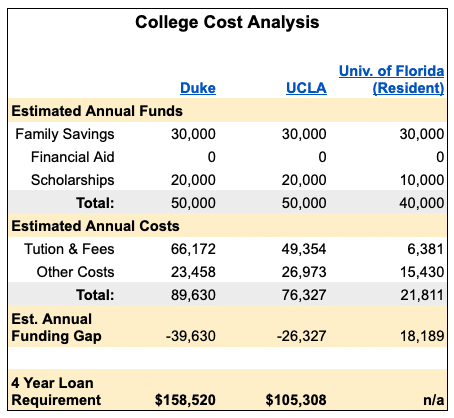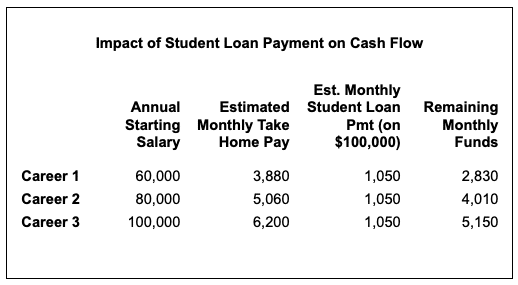
If you are a prospective college student (or the parent of a student) who has begun receiving university acceptances, congratulations! The hard work that preceded this moment is worthy of immense praise. A college degree can open the door to better job opportunities and earning potential. However, although these benefits are desirable, they come at a high cost, so even those with financial resources may face difficult choices. Since this is likely one of the biggest financial decisions you have ever made, my goal in the following text is to help you make the most informed choice possible.
A Reality Check
The college decision-making process can be highly emotional, especially if your dream school accepts you, so I do not want to downplay the difficulty of being pragmatic. Yet, there is a significant financial cost to realizing this dream. Depending on your resources, this cost may be feasible or could mean taking on sizable debt before choosing a career, potentially endangering your long-term financial future.
Many families strain to save as much as they can for their child’s education, but it is nearly impossible to anticipate the exact amount needed since you won’t know the final price tag until mere months before the first bill comes due. To further complicate issues, most middle to upper-class families don’t qualify for need-based financial aid, making it an unpredictable factor for planning purposes.
While many parents with means want to help their children cover any shortfall in savings, by the time children reach college age, parents might be concerned about their retirement savings. If they must choose between paying for a child’s education or saving for retirement, each year they pay for school could delay their retirement by a year. Since continued health is not guaranteed as we age, assuming you can work into your late 60’s or 70’s can be risky. Therefore, it is worth noting that although taking on debt may be unpalatable, student loans exist, whereas retirement loans do not.
Setting The Stage
Before giving any recommendations, I would like to describe a scenario we have seen in our practice to help frame the decision-making process.
We recently met with a client whose daughter, we will call her Annie for our purposes, is a high school senior living in Florida. Annie has worked diligently throughout high school to achieve an excellent GPA and standardized test scores. She applied to numerous prestigious private schools with hefty price tags and state schools for, according to her perception, a fallback option. Annie is highly concerned because, while her parents have worked hard to save money for her education, it is only enough to cover a $30,000 per year state school.
Unfortunately, this situation is incredibly common. Societally, we encourage children to aim high, but many must face difficult decisions when they do. In Annie’s case, she may need to choose between her dream school, Duke, which runs around $85,000 annually (including room and board, etc.), and a state school, such as the University of Florida, which could be nearly free given her academic standing and Florida’s generous Bright Futures Scholarship Program. In other words, Annie must decide if pursuing her dream is worth going into significant debt.
Recommendations
To think this through, I suggest working through the following two steps:
1. Develop a Clear Picture of Your Funding Situation
For most families, discussing paying for college is the first time they openly talk about finances. I would like to point out that this conversation is better had sooner rather than later. It may be uncomfortable initially, but transparency is imperative to an optimal decision. The most important questions to answer are:
- How much money (if any) is already committed to funding your college experience?
- What outcome do you hope to achieve through higher education?
- Is your family willing (and able) to absorb any additional costs?
- Are you willing to take on debt, work through school, or make other concessions to cover funding gaps (see “underfunding risks”)?
While there is no one-size-fits-all way to go about this conversation, the universal first step would be to jot down how much funding is available for your education, regardless of whether it resides in a 529 plan or another savings vehicle. Next, create a list showing each college that accepted you and the four-year cost of each school. Don’t forget to add room and board, books, study abroad expenses, etc. Finally, add any additional funds you expect from financial aid, scholarships, etc.
Your analysis might look something like this.

Identifying and organizing this information will allow you to determine which offers result in funding gaps and what the final loan requirement will likely be. From here, each family’s approach to handling these gaps will be unique, depending on the challenges you face.
2. Review the Risks Below and Apply Any Learnings to Your Situation
Underfunding Risks
If you have a funding gap, an in-depth discussion of using debt as a resource will be necessary. Student loans are easily accessible for covering shortfalls, but they are expensive, so an honest assessment of the anticipated post-grad outcomes and the student’s future earnings potential is vital.
To explore this risk, identify at least three careers you find appealing because statistically, 1/3 of all college students are likely to change their major at least once. Then, research the earnings potential of each option, noting the average starting salary (when the student will begin repaying the loan) and the upper end of the option’s earning potential.
Finally, identify the total debt required, then use a simple calculator to estimate the loan payments and perform your analysis. Are the anticipated earnings from each career enough to cover the debt payment after factoring in living costs? If not, the student may want to consider a less costly school, another career trajectory, or alternatives such as working during college or living more frugally after graduation.

It is worth noting that while analyzing costs and projections of future earnings is a useful exercise for determining debt tolerance, college is not purely a profit-and-loss calculation. College is a time to grow into adulthood and become self-sustaining, the value of which is incalculable and immense.
Suppose you have a passion for a field of study that does not lead to high-income career prospects. In that case, you should still consider pursuing that major as it may help you become the most well-rounded and interesting version of yourself, which will undoubtedly help you in your future career and life. However, you could also consider minoring in a subject with more earning potential to give yourself the skills necessary to succeed in a capitalistic society.
Timing Risks
The most ubiquitous and effective method for funding college education expenses is a 529 plan. Money invested in a 529 plan grows on a tax-deferred basis and can be withdrawn tax-free for qualified education expenses. Many families start 529 plans years before the beneficiary reaches college age and allocate heavily into growth-weighted equity funds due to the potential for significant capital appreciation over the long term.
However, such allocations carry greater risk as children approach college age. If the value of your account drops right before you need it, that will be a problem. Because of this, we pay close attention to 529 allocations as students advance through high school. Time horizon is the most essential factor to consider when allocating your portfolio, and the closer you get to your goal, the less risk you should take. The last thing you want to do is lose the race because you tripped right before the finish line.
This issue grows in complexity if you also plan to use the funds for graduate school. For example, a junior in high school would need money from their portfolio in 2 years, which could justify a low-risk allocation. However, if you wish to earmark some of those funds for post-graduate education, the time horizon is now 6-10 years. That may justify a more growth-oriented allocation.
Overfunding Risk
Occasionally, students choose a cost-effective school or receive scholarships, leaving excess funds in their 529 plans. Although this may sound like a good problem, withdrawing funds for non-qualified education expenses means paying income taxes and a 10% penalty on the earnings. Fortunately, there are other options (that you can combine if needed) to avoid these taxes and penalties.
- Transfer funds to another beneficiary.
You can do this immediately or let the funds grow and do it later, for a future grandchild, for instance. - Roll up to $35,000 into a Roth IRA for the beneficiary.
SECURE ACT 2.0 allows for funds held in a 529 for 15 years or more to be rolled into a Roth IRA. Rollovers must be within the annual contribution limits ($7,000 in 2024), so transferring the entire $35,000 will take several years, but this is a great way to kick off a young person’s retirement savings.
The Bottom Line
The college years are one of the most exciting eras in a young person’s life, and the experience can be even more enjoyable when you are confident in your financial future. To achieve this confidence, analyze your costs and outcomes and take the appropriate steps to mitigate whichever risks apply to your situation. As always, we encourage you to reach out if you wish to discuss your circumstances with one of our advisors.
Author
-

Brady Wright is a Financial Planning Associate at Golden Road Advisors. Brady earned a BS in Business Administration, Finance, and a minor in Wealth Management from the University of Florida’s Warrington College of Business. He is also currently pursuing the CERTIFIED FINANCIAL PLANNER™ (CFP®️) designation.
View all posts



